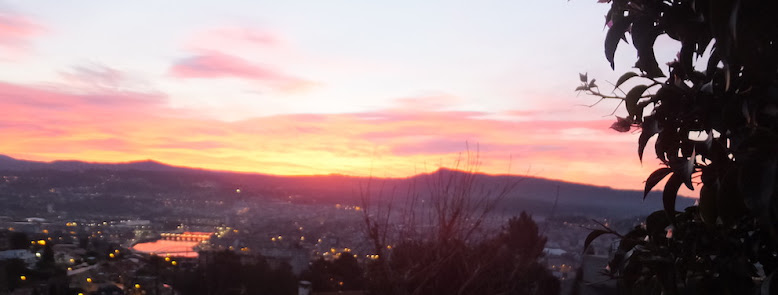
Night’s candles are burnt out, and jocund day stands tiptoe on the misty mountain tops.
Spanish life is not always likeable but it is compellingly loveable.
- Christopher Howse: 'A Pilgrim in Spain'*
Covid 19
Sweden’s ‘success’ again.
Living La Vida Loca in Spain and Galicia
So, now we know. . . The ex-king’s ex-mistress has revealed that he was the victim of a coup d'etat led by his estranged wife, who conspired with then prime minister to force him from the throne in favour of his more manipulable son. Certainly plausible.
Intriguing to see that the current government plans to set up a Public Prosecutor dedicated to pursuing the crimes of the Franco era. I wonder if he/she will see the light of day, given the forces of resistance. La Casta.
The orcas along our coast have forced the authorities to consider banning yachts between Ferrol and Cedeira. Even if they were only ‘playing’ when buffeting vessels.
In 1702, during the War of the Spanish Succession, the combined British and Dutch fleets destroyed both the Spanish bullion ships and their French escorts, in the nearby San Simón Bay. Since when, many folk have tried - but failed - to find at least some of the gold and silver once thought to have gone down with the ships. A chap called Fernando Navarrete made a documentary about this in 1990 but it seems it was never aired. Looking for it, I did at least come up with this. And this.
A reader has kindly advised me of another odd group of Spaniards, this time closer to home in a region of nearby Asturias. I’ve visited it a couple of times and have friends there but had never heard of the Vaqueiros de Alzada who were/are nomadic cowherds, in the mountains of Asturias and León, who traditionally practice transhumance, i.e. moving seasonally with cattle. And who have a culture separate from their non-Vaqueiro Asturian and Leonese neighbors and can often be distinguished by their last names, many of which are unique to them. See here for more. And see a map of the region here.
María's Fallback Diary: Day 5
Spanish
- Bota: Leather container to hold wine, pear-shaped and with a stopper in the narrowest part through which the liquid comes out in a very fine stream.
- Trillo: Threshing board/sledge
- Triturar: To triturate:- 1 : To crush, grind. 2 : To pulverise and comminute thoroughly by rubbing or grinding. As with the triturado version of tomatoes one gets in a can here.
Finally . . .
Here's Richard Ford writing in the 1840s about a Spanish rural scene:-
All classes here gain their bread by making it, and the water-mills and mule-mills are never still; women and children are busy picking out earthy particles from the grain, which get mixed from the common mode of threshing on a floor in the open air, which is at once Biblical and Homeric.
At the outside of the villages, in corn-growing districts, a smooth open " threshing-floor" is prepared, with a hard surface: it is called the era. and is the precise Roman area. The sheaves of corn are spread out on it, and four horses yoked most classically to a low crate or harrow, composed of planks armed with flints, etc., which is called a ‘trillo’: on this the driver is seated, who urges the beasts round and round over the crushed heap. Thus the grain is shaken out of the ears and the straw triturated ; the latter becomes food for horses, as the former does for men.
When the heap is sufficiently bruised, it is removed and winnowed by being thrown up into the air ; the light winds carry off the chaff', while the heavy corn falls to the ground.
The whole operation is truly picturesque and singular. The scene is a crowded one, as many cultivators contribute to the mass and share in the labour; their wives and children cluster around, clad in strange dresses of varied colours. They are sometimes sheltered from the god of fire under boughs, reeds and awnings, run up as if for the painter, and falling of themselves into pictures, as the lower classes of Spaniards and Italians always do. They are either eating and drinking, singing or dancing, for a guitar is never wanting.
Meanwhile the fierce horses dash over the prostrate sheaves, and realise the splendid simile of Homer, who likens to them the fiery steeds of Achilles when driven over Trojan bodies.
These out-of-door threshings take place, of course, when the weather is dry, and generally under a most terrific heat. The work is often continued at night-fall by torch-light. During the day the half-clad dusky reapers defy the sun and his rage, rejoicing rather in the heat like salamanders ; it is true that their devotions to the porous water-jar are unremitting, nor is a swill at a good passenger's ‘bota’ ever rejected; all is life and action ; busy hands and feet, flashing eyes, and eager screams; the light yellow chaff, which in the sun's rays glitters like gold dust, envelopes them in a halo, which by night, when partially revealed by the fires and mingled with the torch glare, is almost supernatural, as the phantom figures, now dark in shadows, now crimsoned by the fire flash, flit to and fro in the vaporous mist.
The scene never fails to rivet and enchant the stranger, who, coming from the pale north and the commonplace in-door flail, seizes at once all the novelty of such doings. Eye and ear, open and awake, become inlets of new sensations of attention and admiration, and convey to heart and mind the poetry, local colour, movement, grouping, action, and attitude.
And here's a couple of fotos I took in NW Iran in the mid 1970s, 175 years later:-


* A terrible book, by the way. Don't be tempted to buy it, unless you're a very religious Protestant.